
|
 |

|
 |
Sandeep Dutta: Dancers should attend workshops on lights - Shveta Arora e-mail: shwetananoop@gmail.com Photos: Anoop Arora January 16, 2020 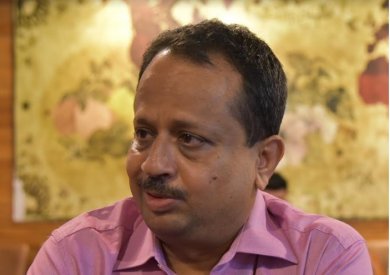 Sandeep Dutta We begin from the end of the performance, after the audience is moving out, when you see the lights being dismantled, the wires being wound and all the equipment being taken apart. And in the middle of this, you see this inconspicuous person who's directing the entire thing, and all that you have seen of him is when he comes on stage at the end for the credits. It is then that you realize how the special effects in the performance were brought out using the lights, how the dancer's emotions in her solo were so wonderfully clear to you, how the spotlight followed the dancer and the colours of the lights changed with the hues of the rasas. Lights designer Sandeep Dutta is one of the most well-known names in Delhi's cultural circles. He has worked on shows for some of the eminent dancers and musicians, both those from Delhi and those performing in Delhi. Light design is integral to creating the right mood and atmosphere in a performance. My photographer husband and I interviewed Sandeep Dutta to find out how he designs the lights for different productions, the challenges for light design in the Indian scenario, and the prospects in the profession. How did you get started in the profession? We came to Delhi in 1986 from UP. My father was a doctor and we had a house in Delhi, so when he retired, we shifted to Delhi. After schooling, I did Electronics from IETE. I was looking for something constructive at that time. Fortunately, I met Gautam Bhattacharya, who became my guru and mentor. We stayed in the same colony and would meet often. He suggested taking up light designing as a career. But at that time, my parents had not heard of light designing. So initially, my father refused. Sometime after that, unfortunately, my father passed away. I told my mother I wanted to try this line and she consented. It was in 1991 that I started going out with Gautam Bhattacharya to watch classical programs, since I did not have any classical base. I did not have any family background in the arts but being a Bengali, I had that gene, an interest in culture that is transmitted. I started enjoying dance and music. Gautam-da told me that I could take this up as a career; he would guide me but not to bank on him, and to learn and create my own base. My mother encouraged me. I enjoyed it and started learning. The first step was to learn the basics - choreography, concept, lights, what the dancers think of the lights and vice versa. Learning with him taught me to think about the dancers' vision. After seven years of learning from him in a guru-shishya parampara, I got my first job as a light designer for a solo show in 1998 with Geeta Chandran. Gautam-da was busy with another assignment and he asked me to go ahead with it. And that was the beginning of the story. Later, through Gautam-da, I met R.K. Dhingra. He also guided me. Did you start with dance only, or did you do music events as well in the initial years? When I started my journey, I worked as an apprentice for Modern Stage Service for free for three to four years, just to learn - where and how the lights are to be put, what angle, what colour etc. To do any light design, you have to have a sense of music - when will it fade out and fade in. Once you have been to a rehearsal, things become clear. And I have now worked in all the fields - dance, music and theatre. 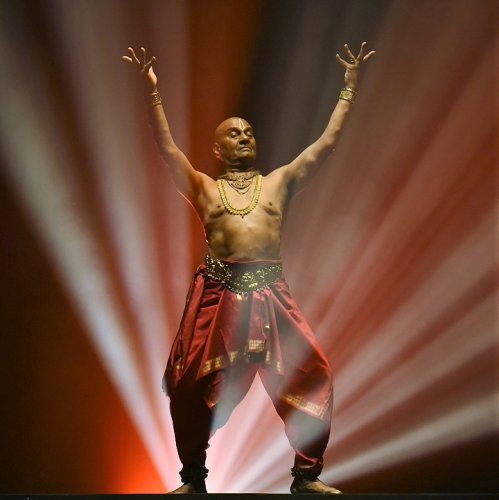 Raja Reddy in Suryam Pranamamyaham, Kuchipudi, 2018 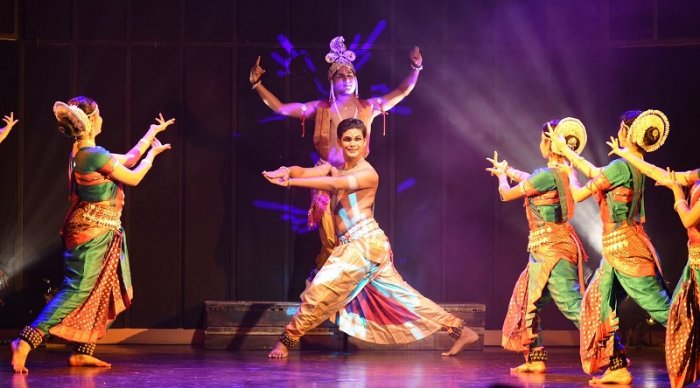 Matsyavatar by Ranjana Gauhar, Odissi, 2016 You have done a course in electronics... did that help? I have a diploma in electronics, but that does not have much to do with this particular field. It helped me understand lights better but as such, it had little to do with this field. Anybody can sit at the panel and manage lights, but to know what lights should be used, what degree, what angle, what intensity, you have to have a sense of lighting. Since when do you think dancers have started recognizing the role of lighting in a production? Initially, it is true that lights were not given much importance in a performance. The focus was the dancer. Lights were used only to enhance the dance and the production. Lights have been used in productions for a long time - Gautam-da started as early as 1970. But he and R.K. Dhingra and others were able to establish the field only in 2004-05. It was only after that, that dancers started taking lights seriously. In north India, particularly in Delhi and Mumbai, it is easier because light design is considered as important as music and dance, but in the south, some people are still sticking to the older version - they are now developing a sense of importance for light design. At what stage of the production do you get involved? With productions like Chitrangada, they involve us from the beginning, when the script is being written, because for lighting, you need gaps in music. They have to incorporate that when they are writing the script. After the script, they start making music. In music, some dancers like to do it in 'cut'; there is no scope for the lights to fade or the other dancers to take the stage, because the cut is so sharp. Some senior dancers plan the music accordingly, so that the light should fade slowly and the other scene should be established. The senior dancers sit with us in the beginning, at the script stage, then when the music is ready, for suggestions while we watch, and then in the last stage, for the final two to three rehearsals, they call us to give the final look of the production. So for a thematic choreography with a storyline, you are involved right from the beginning. When the script is ready, they want to know what the scope of lighting will be. Then they begin the music. But for a regular dance performance, like a margam presentation or an arangetram, or even for a solo performance, one rehearsal is enough. What is the difference in lighting for a solo and a group presentation? A solo production is tougher. If it is a small stage, like in India International Centre, it is still easy. But in Kamani, it is very difficult for a single dancer to cover every corner of the huge stage. We have to plan accordingly how to 'cut' the stage. In a group where 10-12 people are dancing, that becomes easier. And I always suggest that dancers use a black backdrop - that's my preference. Some dancers want to use an audio-visual. But generally, I tell them to use a black background, since the edges are clear and the photos come out better. In solo performances, when an emotional piece is being danced and the spotlight is right above the dancer, there is a slight problem for photographers, which Avinash Pasricha has also mentioned - it throws the eyes in shadow, and however much you change the perspective, that cannot be helped; the eyes look black in photos. What can be done about that? I can speak only for myself - I generally give three or four spotlights for the centre spot, one from the top, one for the face light, and two from the sides at angles of 45 degrees. I try to avoid those 'black circles' around the eyes and so far, I have been 99 per cent successful. Yes, initially, I did face this problem. But if I give any other light from the sides, it ruins the magic of the spot. Sometimes, if I put a light in the front, in front of the feet, the dancer can lose her balance because it could blind her. Another complaint some photographers have is about the intensity of the light. For that, I usually say that these lights are for the human eye, not for the lens. If the lights are on full blast, it will be overdone. Some dancers prohibit flash photography and if the light is also dim, then it becomes an issue in taking a good shot. Generally, whether for a solo or a group, I try to avoid this situation. If there is an opening or an ending scene that demands it, I dim the lights, but I try to avoid very dim lights. And we use amber light, which goes well with the skin tone of Indians, mixed with a bit of white light. Because I know that a photograph is for a lifetime. In India Habitat Centre, for instance, the light is mostly orange. It looks yellow; I mix white in it. I keep in mind that photos should come out well. My guru would not approve of it (changing lights for photography). You must keep up with the times, but the change must be for the better. These days, people are using LED lights. As a photographer, you will agree there is no warmth in it. LED lights are good as backlights. But for face light and front lights, they are the worst choice. I have had to fight for this sometimes when I have refused to use LED, arguing that it will kill the show. It will look like an X-ray - bluish with a strange tinge. That you cannot avoid because they are cold lights. They do not have a colour temperature. For a photograph, you need some warmth of colour. Very few dancers these days understand that every colour has a specific reason. If we use a specific colour, it should be symbolic of something. The younger generation of choreographers do not understand the significance of colour. The choreographers today randomly select colours of light. If the dancer leaves it to me, then I go with my plan. If they want to sit and discuss, we sit down for a meeting and the inputs come from both sides, with mutual understanding. And the third is what the choreographer himself wants. At the end of the day, it is their production; I have to do what is required of me. If they insist, then I leave it to them and go with the colours they insist on. 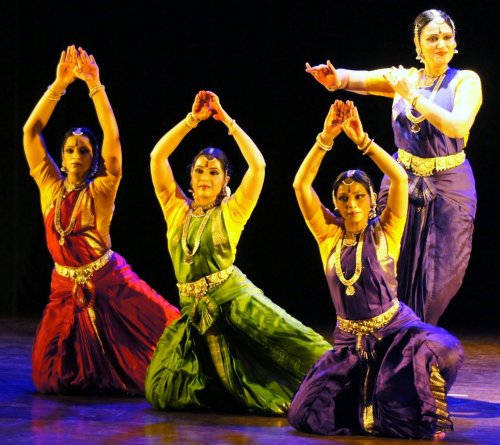 Kaliya Daman by Natya Vriksha dancers, Bharatanatyam, 2014 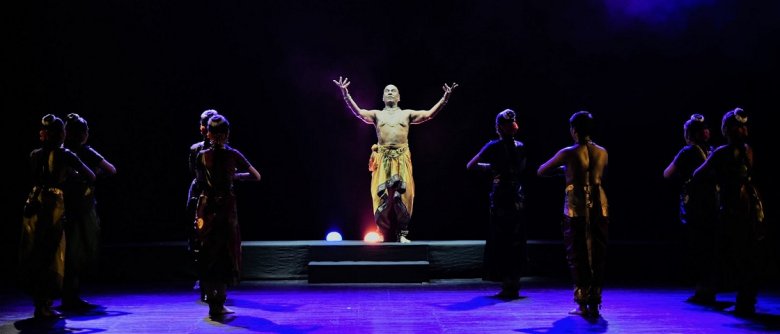 Natya Rasanubhuti by Raja-Radha Reddy and Natya Tarangini, Kuchipudi, 2017 It has been an honour for me to have worked with Ranjana Gauhar, Geeta Chandran, Raja-Radha Reddy, and Sonal Mansingh. They have so much faith in me, sometimes they don't even discuss the light plan. They show me the rehearsal and say, 'It's your job, you know better than we do.' But I too have to bear the responsibility of their expectations. They put great effort into the production, with months of rehearsals. It is a huge responsibility because it comes down to that one day of the show, and on that day on stage, you can make or break things. My attempt is to enhance their hard work, not overpower it. My guru Gautam Bhattacharya once told me that if somebody coming out from the auditorium says the lighting was good, that means that the production has failed. The appreciation for the lights should be secondary. The production comes first. If people remember the lighting, then that means there was nothing in the production. You just said that you don't use LED lights. What are the lights you use and what are the basic colours? I think dancers should attend workshops on lights. I conducted one in Aurangabad recently. My gurus Gautam Bhattacharya and R.K. Dhingra conduct workshops regularly. I do too. The problem with dancers is that they do not know how to take their spot or position exactly. I can understand that while dancing, you are so engrossed that you forget to take your exact position. But when you don't take the correct position, it's a problem for us. Suppose you are standing at the edge of a circle (when you were supposed to be in its centre), you are half in light and half in shadow. It kills the magic of the light. If I give sidelights, the magic is totally gone. I totally understand when the dancers say that 'we are so engrossed that we forget.' But there are others who are very particular - they mark their position and take it exactly. That enhances the production. Otherwise, the look is very flat. I usually try to avoid front lights - I play with the backlights and side cut lights. Cut lights give sharpness in edges. The top light is harsh and kills the mood. Our skin tone is better seen in amber lights mixed with white lights. Europeans ask for warm white light. We face a problem with contemporary dance - they say don't show the face, only silhouettes. Sometimes I ask, why not the face? You cannot see the expressions. Either they are not confident about the subject or about the dancer. For the Indian classical dances, first, you have to be familiar with the mythological stories, since most classical presentations are based on mythology. I do productions for south Indian dancers also. I don't understand the language, and yet, when they start rehearsing, I understand the god they are depicting. All over India, a large percentage of classical dance productions are based on mythology, and lighting is very important in these. In contemporary dance, the performance is slightly abstract and difficult to understand. I don't understand much of it - just about 50 per cent of it. I have to ask them after the rehearsal what they are trying to convey. These days, dancers and choreographers often use multimedia images in the backdrop, or AVs. What is the impact on the lighting? It is my request to dancers that whenever you use multimedia for the production, please don't use an LED wall. No matter how much you crop the intensity of the LED, it is very bright and eats up the corrector. Use a cyclorama, a cloth screen, and have the visuals projected on it, like in Kamani for Rango'ntaratma, or in Shri Ram Kala Kendra. We tell them to use a high projection, 10,000 luminescence minimum, so that the picture does not fade. There we have to be careful not to use front lights at all. The front light will be reflected off the floor of the stage on to the cyclorama and kill the visual. And then we have to see when the projection comes on. If it is during the narration, then it is okay. But if it is during the dancing, then we have to plan how and when to use the projection. Like in Nal Damayanti by Ranjana Gauhar, I had to figure out how to balance the lights, since the visual was on constantly. I had to ensure that the animation and the faces of the dancers were visible at the same time. If there is an LED wall, then the dancer will totally vanish. But thankfully, it was not an LED wall. The glare of the LED wall is so high and the colours so bright that whatever the costume of the dancer, the figure will be lost. The photographer will have to look for the dancer. 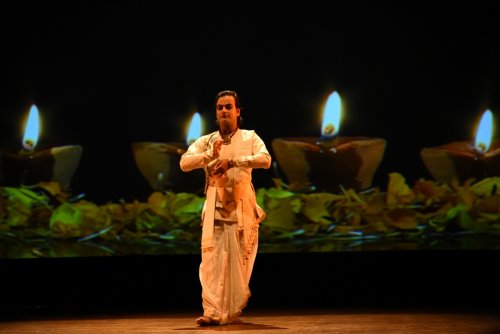 Hemanta Kalita in Rango'ntaratma, 2019. Example of lighting with background video projection. 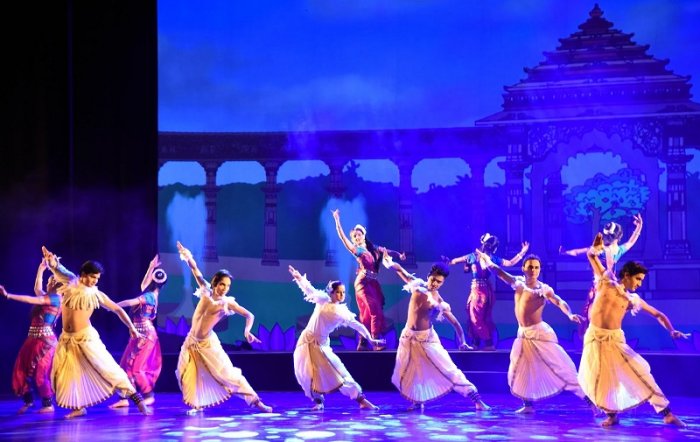 Nal Damayanti by Ranjana Gauhar, Odissi, 2016. Example of lighting while video is being projected onto background throughout production Raja and Radha Reddy did a production on the planetary system last year. They had to use visuals of stars and planets in the background. What was your contribution to that? Yamini Reddy wrote the script and she asked me to see the rehearsal when she was in Delhi, since she stays in Hyderabad. Before that, it was not ready, so she told me about the concept, what she wanted and whether I could produce the required effects. We were regularly discussing the entire scene - her vision and what I could achieve, since everything is not possible. We spoke, going back and forth for two months, but when I watched the rehearsal, I had just two days to make it work. Luckily, it worked well and people appreciated it also. The effects of the sun and the stars and the planets came out well. Here, again, it is experience that counts. It is only experience that allows you to visualize and plan. I keep watching my guru's work and also R.K. Dhingra's work whenever I am free. The old, traditional lights fade in and fade out gradually. The new, 'intelligent' lights come alight with a jerk. Gautam-da is reserved about the use of new lights and prefers the traditional ones. I take my training from Gautam-da for traditional lights and from Dhingra for new lights. In my own way, I have merged the two styles. Are you also teaching? Many people have approached me, but the problem is that neither the dancers nor the technicians (who have approached me) want to give a lot of time to learning. They think that the panel and controls are the main thing. You have to manage the fixing of the lights, balance them and also get the right colours. Then, when I ask them to complete at least six months of training, they vanish. Those who are a little earnest come for three to four shows and then ask, 'When can I operate a panel on my own?' I tell them it took me seven years, watching my guru. But if you want to start like that, okay, it is your choice. Many dancers see that I am working with Bharatanatyam, Odissi, Kathak and other forms and they say, 'Sandeepji, I wish I were also in lights, I would also work with all dance forms.' But I tell them that they have not seen the last 20 years of my life and my struggles. There's a good time for some things - that's what they're seeing now. My guru was very strict. I am what I am today because of my guru. Luckily, I was at the right time, at the right place when I started out. What are the prospects in this profession? Can it be made into a full time profession? So far, this is my full time profession. Productions by dancers are supported by grants from the government and private sponsors. I am happy with what I take home. Throughout the time my guru was working, there was no money in this field. It was only in 2005 that people started realizing the importance of light designing. The credit for this goes to Gautam-da, who won the SNA award for lights in 2006. He has sown the seeds of which we are reaping the fruits. Most of the light designers at present in Delhi have been trained by him - Milind, Sharad, Nitin Jain. The equipment in Kamani is at par with anywhere in the world. I have travelled abroad with many productions. The only difference between here and other countries is that foreign crews want a planned program in the beginning. They are more professional and exacting in their standards. They just want me to give them a plan and they set it all up accordingly. In fact, last minute changes are difficult since everything is planned and rigged. During the show, there are only two people in the auditorium - one for the sound and one for the lights. No assistants. I was in Britain with a production and reached the auditorium early in the day, as is my practice. They told me I need not come early since my plan is already with them. Everything will be focused and programmed; only 20 per cent will be determined by the spots. By the time I was allowed to enter, everything was set up according to my plan. That is the extent of their professionalism and dedication. The exceptions were in the US, where sometimes they are casual in their approach. It varies - in Los Angeles, Houston and New York, they are professional, whereas in San Jose and San Francisco, they are less efficient. How do you do lighting for a music show in which the artiste is not moving? Some artistes like Prateek Chaudhuri want to play with the light according to the raga and the mood. Generally, once the artiste is seated, the lights don't change… But in one performance, vocalist Vidhi Sharma collaborated with dancer Maitreyee Pahari. Here, you have a dancer in the forefront and the vocalist also to highlight. So the vocalist is supposed to look brighter since she is the focus. Plus, we have to figure out which lights have to be used according to the theme of Kabir. A performance on Shiva or Buddha will have green or blue colours, and raudra Shiva will have red. It is a subjective choice. How has your experience in theatre been? In theatre, the problem is of sustainability. The budget is a problem. In Hindi theatre especially, they have to work within the constraints of their budget. You can do a few productions for less money but you have to run your home as well. Sometimes dancers do not have a large budget. Then, for goodwill, I may agree to work for less. Sometimes, a senior dancer is working for free for either a charity or an NGO, and she requests you to work for her. If I am free and available, I do work for free in these cases. Eventually, money is not everything. Any memorable experience of working with someone? 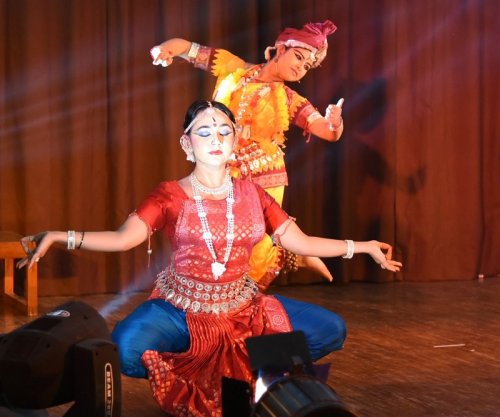 Chitrangada by Ranjana Gauhar, Odissi, 2019. Example of maintaining light focus on both foreground and background It was memorable to be a part of Chitrangada by Ranjana Gauhar, since it was a challenge for all of us. It is all Rabindra sangeet, and Odissi cannot be done to Rabindra sangeet. She had to change the tempo of the music to suit the dance. She was very worried about criticism for tampering with Rabindra sangeet. She took the production to Kolkata and it was widely appreciated. They got a standing ovation. Some challenges you face... Sometimes a show requires you to put up the ramp and the lights also. Some people book the auditorium from the morning of the show onwards, but some others cannot afford it and book it only from the afternoon, roughly 2.30pm onwards. You gain entry to the auditorium at 2.30, and then there are so many people all trying to set up at the same time. And there is the deadline - you want to finish at least half an hour before gates open. So those are pressure situations - for some of those shows, you cannot give your best; you just get the show done somehow. I cannot say that I am perfect. There are always errors; sometimes we miss the cue or the timing of fade in and fade out goes wrong. It also depends on how discerning the audience is, whether they spot the error. There, we are lucky sometimes. Sometimes, the host artistes get angry.... There is the possibility of error in anything you do. In European ballet, if they prepare a production, they have a company doing it. They have their in-house light and music designers. They rehearse hundreds of times and then they travel and perform the production a hundred times. I have also assisted them a few times, especially the Russian companies. The light designer records the performance and the spots for each dancer are marked. The dancer will reach the right spot even in the dark. The entire production is recorded on the panel and the lights designer just sits there to check. It is not done manually, so human error is minimized. There are many differences between an Indian production and a foreign production. Nobody here will hire a light system in an auditorium for three to four days so that the panel can be fed the instructions. The positions or spots for the dancers cannot be marked because they will not come to the same spot each time. One dance guru is burdened with managing everything in a production. I am burdened by working for different dancers at the same time and in different forms, each one with different requirements. In a Russian or any other foreign production taking place in say, Siri Fort (Delhi), everything is planned. They do it every day with the same precision, performance or not. It is like a job for them. It is a mega event on a huge scale. Show or no show, they work and rehearse 10 to 5 every day for the company. So there is a huge difference in the professional outlook. But there are few rehearsal spaces here. For an evening program, if you get the hall at 2pm, you don't get time for a whole run-through because the makeup also has to be done. It starts at 4pm for a 6.30pm show, so where is the time? But there are dancers who do give importance to lighting and can afford to book the auditorium a few days ahead. It all depends on the budget. How many people can afford to book Kamani for a whole day? And the culture of pay-and-watch has been successful in Mumbai, but not Delhi. Here, people look for free invites for not only classical but other events also - even for Bollywood or pop shows. Only three or four people have the standing and popularity to fill up a large auditorium - Pt. Birju Maharaj, Raja-Radha Reddy to name a few. Otherwise, despite it being free, people don't attend. Are there any institutes or training centres where people can learn to do the lights as a career? We have learnt in the guru-shishya parampara, those of us who are practising. The new people want shortcuts and jobs right away. It looks easy - turn light on / off - but you need patience, a clear mind, coordination. That is not learnt very easily. I remember the first time I went to work, it wasn't even many lights, it was a solo, but I was very nervous. And maybe there are differences in the gurus then and now. My guru used to come and watch us, sit at the back, and leave before the show ended. He would ask the next day and then we would realize that he had been there. He taught us many subtleties of the stage - there is a decorum of the stage to be maintained. Not just for lights - the wings should be set up properly, the light source should not be visible as far as possible. The mic wire should be neat - even though that is not the light designer's job. That is missing today. People want to come, do their job and leave, that's it. We were lucky that we imbibed these disciplines from our gurus and learnt with patience. They taught us the details of the job, how to do it thoroughly. It is not my job to look at the ramp, but I do. For instance, when I send requirements to light companies in Delhi, they know it is from me because of the great detail. For instance, I will say, send 24-power (there are flood and spot, two types) lights. If you don't specify which one, the vendor will send any. Then you will suffer because that might not be the light you needed. There was a show in the Taj hotel for the Election Commission. I sent the details to the vendor; he met me and said it will be done. He had brought LED lights on the evening, there were no power lights. He kept saying they are coming. Finally, I said, 'Tell me now whether it is coming or not, because if not, I will tell the organizer I will not do the show, because I will not do something badly.' Then, when I put that pressure on them, they got a few lights which I had to then work with somehow, though they were not adequate for my plan. Those are the challenges sometimes. I have no lights of my own. I just watch the rehearsal and make my own list of lights according to my requirements. If they are doing it in an auditorium, I request them to tell me which lights are already available in the auditorium. Then I add to or reduce my list and send it to them accordingly. The organizer will then arrange the additional lights according to my requirements. Sometimes people have their own vendors, sometimes I refer mine. I just request them not to use cheap, DJ-type vendors. We have suffered because of bad lights. Now, I give them a list of preferred vendors and request them to take quotes from any they find suitable. For instance, there are 80 per cent lights in Kamani, but 20 per cent we might need for specific effects. Habitat has most lights. It also differs from production to production. Contact Sandeep Dutta at: sandeepdutta70@gmail.com Shveta Arora is a blogger based in Delhi. She writes about cultural events in the capital. Comments * Thanks to Narthaki for providing space for Back Stage persons & Shveta ji to make it possible. - Sandeep Dutta (20 Jan 2020) Post your comments Unless you wish to remain anonymous, please provide your name and email id when you use the Anonymous profile in the blog to post a comment. All appropriate comments posted with name and email id in the blog will also be featured in the site. |